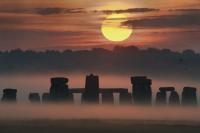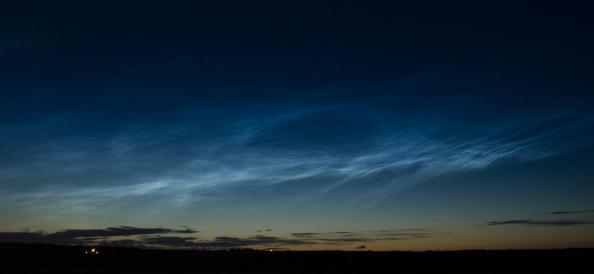In this month's edition
Planetary Skylights

Jupiter continues to linger low in the evening twilight sky over in the NW, but by the end of the month finally drops into bright solar glare and is lost to view. The moon lies nearby on June 1st.

Mars remains quite conspicuous in the late evening sky over in the SW and is now once again in prograde motion (moving west to east as seen against the background stars) Telescopically Mars appears quite small with just a hint of surface detail visible. The moon lies nearby on June 7th.

Saturn is now the best placed in the evening/overnight sky. Look for it due south around 11pm, a bright pearly 'star' a couple of hand spans above the horizon. Through a scope the stunning rings should be quite apparent - one of nature's finest sights. Look for Titan, Saturn's largest moon as a speck of light nearby, it circles round Saturn twice a month in an anti clockwise direction. Saturn lies near our moon on the 10th.

Mercury is a difficult object briefly visible just above the NW horizon in bright twilight on the 1st and 2nd of June, before once again it slips out of sight. The moon lies off to the left on the 1st. Brilliant Venus lingers just above the SE horizon, but you will have to be up around 4am to spot it!
June Meteors

The weak Ophiuchid meteor shower has two maxima, June 9th and June 20th. The zenith hourly rate (ZHR) barely exceeds sporadic levels (5 - 8 per hr) Observe post midnight. The poorly observed June Lyrids peak on the 15th/16th, again the ZHR is only 5-6 per hour
In Focus The Summer Solstice
 Where has this year gone? Here we are already into June and approaching the Summer Solstice which occurs on June 21st. The word 'solstice' is derived from the Greek for 'Sun' and 'stoppage'. From our perspective the Sun stops moving north in the sky reaching its greatest altitude on the ecliptic; the path it follows across the sky during a year. From our latitude in the northern hemisphere this equates to near 60 degrees above the southern horizon at midday. The Sun then starts to retreat southwards once again as the axial tilt of Earth begins to shift away from the direction of the Sun.
Where has this year gone? Here we are already into June and approaching the Summer Solstice which occurs on June 21st. The word 'solstice' is derived from the Greek for 'Sun' and 'stoppage'. From our perspective the Sun stops moving north in the sky reaching its greatest altitude on the ecliptic; the path it follows across the sky during a year. From our latitude in the northern hemisphere this equates to near 60 degrees above the southern horizon at midday. The Sun then starts to retreat southwards once again as the axial tilt of Earth begins to shift away from the direction of the Sun.
Thousands of years ago the position of the summer solstice stood before the stars of Cancer in the northern hemisphere, but has subsequently shifted due of the effects of precession, Earth's slow axial wobble. From our latitude the Sun never appears overhead, but may do so anywhere between latitude 23.5 degrees N or 23.5 degrees S of the Equator, casting no shadows, a phenomena astronomers in antiquity duly noted.
Because the summer solstice then stood before the stars of Cancer, the latitude of 23.5 degrees N became known as the tropic of Cancer. Similarly, when the Sun reached its southern limit on the ecliptic (the winter solstice) 23.5 degrees S of the celestial equator it then stood before the stars of Capricorn, the origin of the tropic of Capricorn.
Although known as the longest day, earliest sunrise and latest sunset do not occur on the summer solstice date. From Whitby earliest sunrise actually occurs on June 16th at 04:25am, whilst latest sunset occurs on June 25th at 21:42pm. It is the duration of useable daylight that does reach a maximum on the 21st, which from our latitude is just over 17 hours. The Sun only dips below the horizon a meagre 12 degrees, barely enough for nautical twilight to exist!
It often surprises how many people wrongly assume that Earth is closest to the Sun during our summer, in fact the opposite is true. Earth is actually furthest from the Sun on July 4; almost 95 million miles distant, three million miles further than when at its closest approach in early January! The reason days feel warmer in summer is due to the higher concentration of sunlight per unit area, caused by the axial tilt of the Northern hemisphere toward the Sun. The intensity of solar radiation is then equivalent to approximately 1.2KW of heat for each square metre, enough to boil some kettles. Then again, you need to boil a kettle for a warming drink on all too many of our summer days!
Noctilucent cloud
 With bright twilight now persisting well into the night, observers of the sky may like to keep an eye open for a particularly beautiful type of cloud formation seen only at this time of year. Known as Noctilucent cloud, these delicate formations appear in the twilight sky above the northern horizon, long after sunset, even after midnight.
With bright twilight now persisting well into the night, observers of the sky may like to keep an eye open for a particularly beautiful type of cloud formation seen only at this time of year. Known as Noctilucent cloud, these delicate formations appear in the twilight sky above the northern horizon, long after sunset, even after midnight.
Shining quite brightly, Noctilucent cloud is filamentary in structure, having a characteristic silvery-blue colour. It forms almost exclusively between latitudes 50 and 60 degrees north, high in the upper atmosphere: 50 miles up- five times higher than normal clouds. The cloud forms when water vapour condenses at the low temperatures that prevail at such altitudes onto particles suspended in the air. More frequent sightings of Noctilucent cloud over the last 40 years may indicate that these particles could be a result of industrial pollution, perhaps from increased air traffic.
- Log in to post comments
